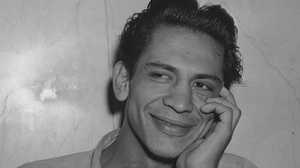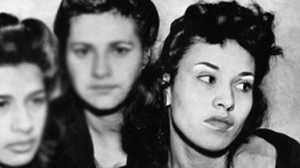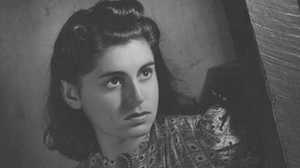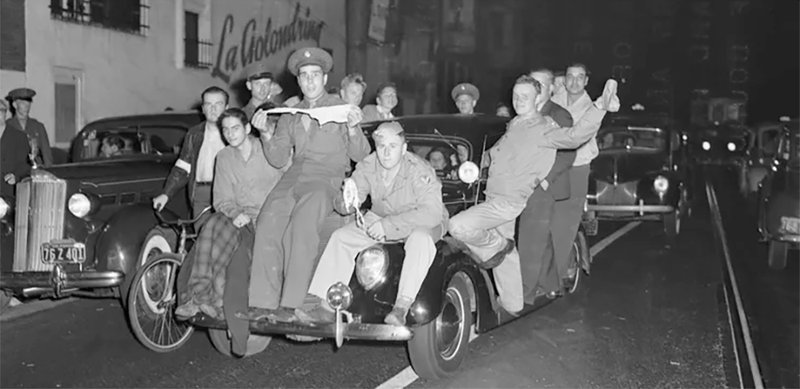
The Sleepy Lagoon Murder
The “Sleepy Lagoon” was simply the name given to a water reservoir on the Williams ranch in a rural area of Los Angeles County. The reservoir was used primarily to irrigate crops, but for many young people in what is now Bell, California, it was also used as a swimming hole by day and a lover's lane by night. On August 1, 1942 the Sleepy Lagoon became part of Los Angeles history when the murder of a young man on the Williams ranch resulted in a violent clampdown by the police against Mexican American youth.
That summer night began with romance but ended in a violent death. In the early evening several young couples from Los Angeles' 38th Street neighborhood arrived at the Sleepy Lagoon. Among the couples were Hank Leyvas and Dora Barrios. Hank was one of the older boys that hung around the 38th Street neighborhood where his girlfriend Dora lived. As they sat in their car that night, under the light of a waning full moon, they were suddenly and viciously attacked by a group of Russian immigrant boys that Henry knew from Downey. Hank and Dora were beaten mercilessly.
After the attack, Hank and Dora drove back to 38th Street to gather reinforcements. Finding people to accompany them was not difficult. Hank was immensely popular and the boys they were going after had violated an unwritten rule by beating Hank's girlfriend Dora. Close to 30 young people — boys and girls — piled into cars and headed back to the Sleepy Lagoon.
That same night José Díaz, who lived on the Williams ranch, decided to attend a birthday party on the ranch held in honor of one of his neighbors. In just a few short days, José was scheduled to report for induction into the Army and head for boot camp. The birthday party was a lively fiesta with food, music, dance and plenty to drink.
When Hank Leyvas and the others returned to the reservoir where they had been beaten, the Downey boys were nowhere to be found. But they could hear the sounds of a party underway at a cluster of homes on the Williams ranch. Convinced that the Downey boys could be there, Hank and the others converged on the partygoers. The fighting was brutal. Men and women, boys and girls struggled for about ten minutes. The fight had all the markings of a teenage rumble, except for what neighbors discovered shortly after the fighting. Lying in the shadows a short distance away from the party was José Díaz. He was mortally wounded, having been beaten and stabbed. He died later that night at Los Angeles General Hospital.
The governor, Democrat Cuthbert L. Olson, was becoming increasingly concerned about wartime juvenile delinquency. He used the murder of José Díaz as a call to action. The Los Angeles Police Department (L.A.P.D.) and the Los Angeles County Sheriff’s Department rounded up more than 600 youth — mostly Mexican Americans — and indicted Hank Leyvas and twenty-one others for José Díaz's murder. The subsequent trial dominated headlines in the City of Angels for months, and tabloid journals called for their conviction. The jury agreed. Even though nor murder weapon, witness, or a confession could be produced, the jury nonetheless found the young men guilty of murder. Hank Leyvas, among the others, was sentenced to life in San Quentin.
Within months of the convictions, Los Angeles erupted in the Zoot Suit Riot. For the better part of a week, servicemen from different armed forces dragged kids off streetcars, from restaurants, and out of movie theaters. Those who were found wearing zoot suits were beaten and often stripped of their clothing. Thousands of white civilians cheered them on and helped the sailors. As the riot progressed, Mexican American boys moved to defend their neighborhoods, setting traps for military men and assaulting them in their cars. The L.A.P.D. let the riot continue for the better part of a week. After the riot ended, the Los Angeles City Council banned the wearing of zoot suits on Los Angeles streets.
Within a year of the riots Hank Leyvas and the boys were released from prison. Their convictions in the Sleepy Lagoon case were overturned on appeal. The court ruled that there had been serious errors in the trial: a biased judge, the denial of counsel, and a lack of evidence. Authorities declined to retry the case. Whoever killed José Díaz got away with murder.
When Hank and the boys returned, the City of Angels, and their place in it, was changed forever. In little time the zoot suit style faded from view. And eventually the small reservoir known as the Sleepy Lagoon fell victim to urban sprawl and was filled in.
The Zoot Suit Riots of 1943
Census information tells part of the story. In the decades leading up to the rioting, Los Angeles experienced an unprecedented population explosion. Along with Midwesterners who flocked to Los Angeles, thousands of Mexican refugees fleeing the Mexican Revolution made their way there. So too did landless white laborers escaping the Dust Bowl of the drought-plagued Southern Plains, and African Americans seeking more opportunity than they'd found in the South.
The coming of war in 1941 further complicated the city's social dynamics. White men went off to fight in a segregated military, and women and people of color filled the jobs in the defense industry previously reserved for white males. Rather than embrace such events as social advances, many whites accepted the changing social realities only as the lesser of two evils — the greater being German and Japanese militarism. While wartime conditions reconfigured gender and racial boundaries, segregation was emphatically reinforced in other areas. Civilian and military leaders in Los Angeles all too easily saw cultural and racial difference among Japanese Americans as subversion and betrayal, and actively supported the forced relocation of Japanese Americans into camps set up in the rural West.
Many Angelenos saw themselves on the frontline of the battle with Japan and felt vulnerable to a West Coast attack. Civilian patrols were established throughout the city and Los Angeles beaches were fortified with anti-aircraft guns. Southern California also served as a key military location with bases located in and between San Diego and Los Angeles. Consequently, up to 50,000 servicemen could be found in L.A. on any given weekend.
Independent of these social tensions, young people were growing fascinated with jazz. It was a musical, cultural, and even ideological expression that was far removed from the Hit Parade music commonly played on mainstream radio. Jazz music and dance were sensual, expressive, joyous, and raucous. Jazz musicians openly defied segregation by mixing on and off the stage, and jazz enthusiasts also mixed on and off the dance floor.
The zoot suit was one part of the jazz world that visually defied the norms of segregation. Unwritten rules demanded that people of color remain unseen and unheard in public spaces, but the zoot suit, with broad shoulders, narrow waist, and ballooned pants, was loud and bold. Zoot-suited young men (and some young women) held themselves upright and walked with a confident swagger that seemed to flow from the very fashion itself. As the Sleepy Lagoon murder trial of 1942, involving mostly Mexican American young men, proved, this particular demographic, zoot-suited or not, came to be singled out and associated with criminality and gangsterism by Los Angeles authorities. In a time of war, when social boundaries were rapidly changing, questions of allegiance and conformity became invested with particular significance. Many Angelenos objected to the zoot suiters — including, incidentally, older generations of Mexican Americans, whose communities were traditional, conservative, and self-contained. Critics saw Mexican American youths as cultural rebels and delinquents who openly defied cherished American values and customs.
Tensions between servicemen and civilians were on the rise as thousands of military men on leave poured into Los Angeles, seeing the city as a playground for booze, women, and fights. While many civilians tolerated them because of the war effort, others did not. Particularly in the segregated, ethnic enclaves of Los Angeles, unruly servicemen met stiff opposition from young men and women who refused to defer to the presumed prerogatives of white privilege. While white military men and civilian youth of all colors clashed in the streets, confrontations occurred most frequently between white servicemen and Mexican Americans, because they were the largest minority group in Los Angeles.
Drunken military men on their way back to base after a night of carousing were often "rolled" by civilian minority youth hoping to teach them proper respect. With equal animosity the sailors would often insult Mexican Americans as they traveled through their neighborhood. In the barrios, rumors spread about sailors searching out Mexican American girls. On the military bases, stories circulated about the violent reprisals suffered by sailors who dared to date Mexican American females. Sailors complained bitterly about their wives or girlfriends being subjected to the sexual taunts of young Mexican Americans. The tension continued to escalate until a street fight between sailors and Mexican American boys sparked more than a week of fighting in June of 1943 known as the Zoot Suit Riots.
On the evening of Monday, May 30, 1943 about a dozen sailors and soldiers were walking on a downtown street. After spotting a group of young Mexican American women on the opposite side of the street, the sailors and soldiers changed direction and headed their way. Between the military men and the young women stood a group of young men in zoot suits. As the two groups passed each other, Sailor Joe Dacy Coleman, fearing he was about to be attacked, grabbed the arm of one of the zoot-suited young men. Coleman's move proved to be a big mistake. Coleman was almost immediately struck on the head from behind and fell to the ground, unconscious. Other young civilians pounced on the sailors with rocks, bottles and fists. After the ferocious attack, the sailors managed to escape and carry Coleman to the safety of the Naval Armory. This initial fight lasted little more than a few minutes, but the shock reverberated for days. The details of the fight grew larger and more distorted in each re-telling of the story. It wasn't long before sailors organized a retaliatory strike against zoot-suiters.
About 50 sailors left the Armory on the night of Thursday, June 3, armed with makeshift weapons. The attack on Seaman Coleman was still fresh in their minds and rumors of new attacks were swirling through the base. Their first stop was the nearby neighborhood of Alpine Street — scene of many previous confrontations. Unable to find any zoot-suiters at Alpine, they proceeded toward downtown and stopped at the Carmen Theater. After turning on the house lights, the sailors roamed the aisles looking for zoot-suiters. The first victims of the zoot suit riots — 12 and 13-year-old boys — were guilty of little more than being in the wrong place at the wrong time. Ignoring the protests of the patrons, the sailors tore the suits off their bodies and beat and clubbed the boys. The remains of their suits were then set ablaze.
As the mob of sailors moved on, reports began to reach the Armory's watch commander. Executive Officer Lieutenant Charles Bacon was sent to investigate. After failing to find any evidence of wrongdoing at numerous spots, Bacon came upon the Shore Patrol marching a group of 60 men to the Central Police Station, where they were to be placed in jail. Bacon assumed control of the situation and saw to it that no charges were recorded by the Shore Patrol.
As the second night of rioting began, Mexican American young men drove back and forth in front of the Armory, hurling epithets at the guards. Later that night sailors once again headed out in search of trouble. When the sailors could not find enough zoot-suiters, they decided to take the fight into the Mexican American neighborhoods of East Los Angeles and Boyle Heights. It was a new twist on the violence: instead of focusing their attacks in areas where sailors and civilian youth had clashed, the sailors moved into the Mexican American neighborhoods. Thus their retaliatory strike became an assault on the Mexican American community itself. The sailors cruised the barrio, storming into bars, cafes and theaters.
Los Angeles police were unwilling to step in and protect civilians. One policeman was quoted after the riots as saying: "You can say that the cops had a 'hands-off' policy during the riots. Well, we represented public opinion. Many of us were in the First World War, and we're not going to pick on kids in the service."
The violence continued during subsequent nights, enveloping even those who had no connection to jazz or the zoot suit. When a group of Mexican musicians exited the Aztec Recording Company after a recording session, they too were attacked. The musicians were all adults, and none of them wore a zoot suit. Military commander Clarence Flogg reported that there were "hundreds of servicemen prowling downtown Los Angeles mostly on foot—disorderly—apparently on the prowl for Mexicans." The Navy reported that "Groups vary in size from 10 - 150 men and scatter immediately when Shore Patrol approaches. Men found carrying hammock cues [clubs], belts, knives and tire irons..."
Although groups of armed servicemen roamed the streets attacking civilians, the military seemed more concerned with regaining control over their men than with the violence they were committing. Leery of the negative press that would result from mass arrests, Admiral Bagley, the commanding officer, appealed to his sailors' "common sense."
Mexican American kids organized and fought back. Rudy Leyvas and his friends set traps for the sailors and civilians who were pursuing them, using decoys to lure their attackers in to a trap. "And they let out a cry: There they are! There they are! And they came in. As they came in, once they got all the way in, we all came out … I, myself, had a bat. And I used it."
The worst violence occurred on Monday, June 7. One Los Angeles paper printed a guide on how to "de-zoot" a zoot suiter: "Grab a zooter. Take off his pants and frock coat and tear them up or burn them." That night a crowd of 5,000 civilians gathered downtown. By this time the mob was no longer made up of only sailors from the Armory. Soldiers, Marines, and sailors from other installations as far away as Las Vegas eagerly joined in the assaults. Part of the mob headed south for the predominately African American section of Watts and another group headed east for Mexican American East Los Angeles.
Al Waxman, editor of the Eastside Journal, a small Jewish newspaper, witnessed the chaos. He describes a "mass of humanity locked in violent struggle, arms swinging, legs kicking, shrieking with anger." The police were arresting dozens of young Mexican Americans. "Why am I being arrested?" one of them asked. The response was a savage clubbing with a nightstick. Although the boy fell to the sidewalk unconscious, he was kicked in the face by police.
By Tuesday morning the rioting was finally under a measure of control. Senior military officials declared Los Angeles off limits to all sailors, soldiers and Marines. The Shore Patrol gave orders to arrest disorderly personnel. The following day the city council adopted a resolution that banned the wearing of zoot suits on Los Angeles streets, punishable by a thirty-day jail term.
As the riots subsided, the governor ordered the creation of a citizens' committee. Its charge was to investigate and determine the cause of the riots. In 1943 the committee issued its report; it determined racism to be a central cause of the riots. At the same time, Mayor Fletcher Bowron came to his own conclusion. The riots, he said, were caused by juvenile delinquents and by white Southerners. Racial prejudice was not a factor.

Dr. Eduardo Obregón Pagán is the Bob Stump Endowed Professor of History at Arizona State University, and Associate Dean of Barrett, The Honors College. He is the author of Murder at the Sleepy Lagoon: Zoot Suits, Race, and Riot in Wartime L.A. (University of North Carolina Press, 2004), and Valley of the Guns: The Pleasant Valley War and the Trauma of Violence (University of Oklahoma Press, 2018). He was a co-host on the popular PBS series History Detectives, and is an adjunct curator of history at the Desert Caballeros Western Museum.
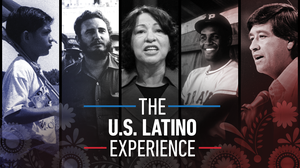
Explore our new collection featuring a selection of films documenting the U.S. Latino Experience — along with articles and original features exploring America’s continued struggle with democracy, inclusion and justice for Hispanics and Latinos, and celebrating their contributions to the American story.
Explore nuestra nueva colección: una selección de películas que, documentan experiencias latinas en los Estados Unidos, junto con artículos y videos originales que exploran la lucha continua de los Estados Unidos por la democracia, la inclusión y la justicia de los latinos y que, celebran sus aportes a la historia del país.




